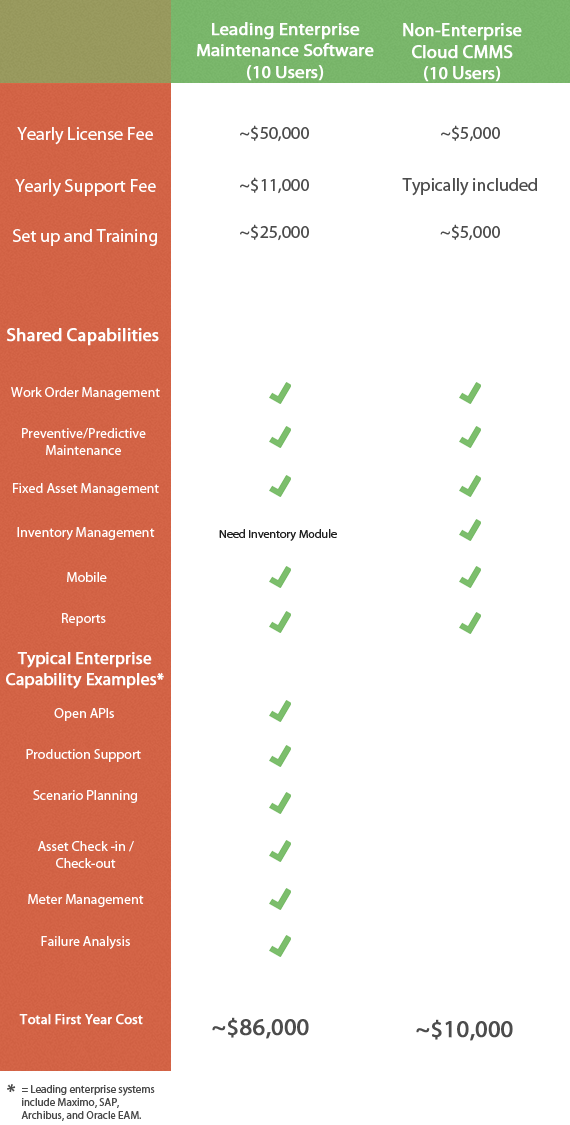Why You Should Reconsider Buying Enterprise Level Maintenance Software
Have you ever been a part of a team that is using a complex enterprise software system and thought, “This is too much software”? If you have, you’re not the only one. Having worked with several enterprise systems over the years, I have come to a common conclusion - that something simpler would have been better.
Large organizations usually require enterprise level software because of their need to track, budget, and maintain assets at the corporate level. This can become costly to individual departments, because of wasted manpower and expensive unused features. These are mostly due to enterprise’s notoriously complex interfaces. The alternative to enterprise systems are software packages that are designed for specific departments, we’ll call these “non-enterprise systems”. Before we can compare the two, we will need to understand what differentiates them.
Enterprise level software includes many software modules, one for each department within an organization. Each module has the ability to share and exchange data with other modules within the system or other outside systems. These exchanges happen in real-time and reports can be generated across many databases. Let’s say a manager wants to know the current total cost of a specific asset. Total asset costs include: capital costs, repair costs, and labor costs. Capital cost data might be found in the company’s financial software module, repair cost data might be found in the warehouse’s supply chain software module, and labor cost data might be found in the human resources module. An enterprise package can access all of these systems to generate the required asset report the manager is looking for. Non-enterprise systems do not have this ability.
Non-enterprise systems are stand-alone. This means they cannot communicate directly with other systems within an organization. However, the total cost report example above can still be obtained by entering data into each departments’ software separately. Some stand-alone software, such as computerized maintenance management systems, can be customized to track this data using custom form fields. The only drawback to doing this happens when data needs to be changed; each individual system containing the data needs to be updated. This can lead to inconsistent data between departments over-time.
This is the crossroad that many organizations come to when choosing between an enterprise and a non-enterprise solution. Enterprise level systems are more functional, but will cost much more and are more likely to be underutilized because of their complexity. Non-enterprise systems cost less and are simpler to use, but lack some functionality.
What is more than common among many organizations that have implemented enterprise maintenance software is that the decision was made because, “management says that we need to interface with [pick your department]”. For this reason, hundreds of thousands of dollars are spent on software, adoption, and staff, only to realize the features that only an enterprise system could deliver, were barely or never used.
To determine which type of system is right for your organization, try doing a basic cost – benefit analysis. One way to determine your cost benefit is to construct a needs vs cost matrix (If you are wondering what some other companies are doing, here is a good link to get you started - company trends). Below is an example using approximate costs, to compare a leading enterprise maintenance software to a non-enterprise cloud based Computerized Maintenance Management System (CMMS).

As you can see, the cost of an enterprise system will cost thousands of dollars more than your typical CMMS. If you only need cost roll ups across departments or specific data collected a few time per year to satisfy corporate, then enterprise might be hard to justify (even taking into account additional labor to gather data in a CMMS). This is especially true if the system demotivates your team and they stop using it all together.
I have one, Fortune 1000 Company, client that added a maintenance module to match up with their current enterprise system a few years ago and they still can only use the module to track building keys. It is too complicated for anything else. For daily facility operations they use a CMMS.
So if you need to get facility operations going, consider a stand-alone CMMS and if you grow out of it someday - congratulations!
Ryan Noble
Ryan is Q Ware's Marketing Specialist.